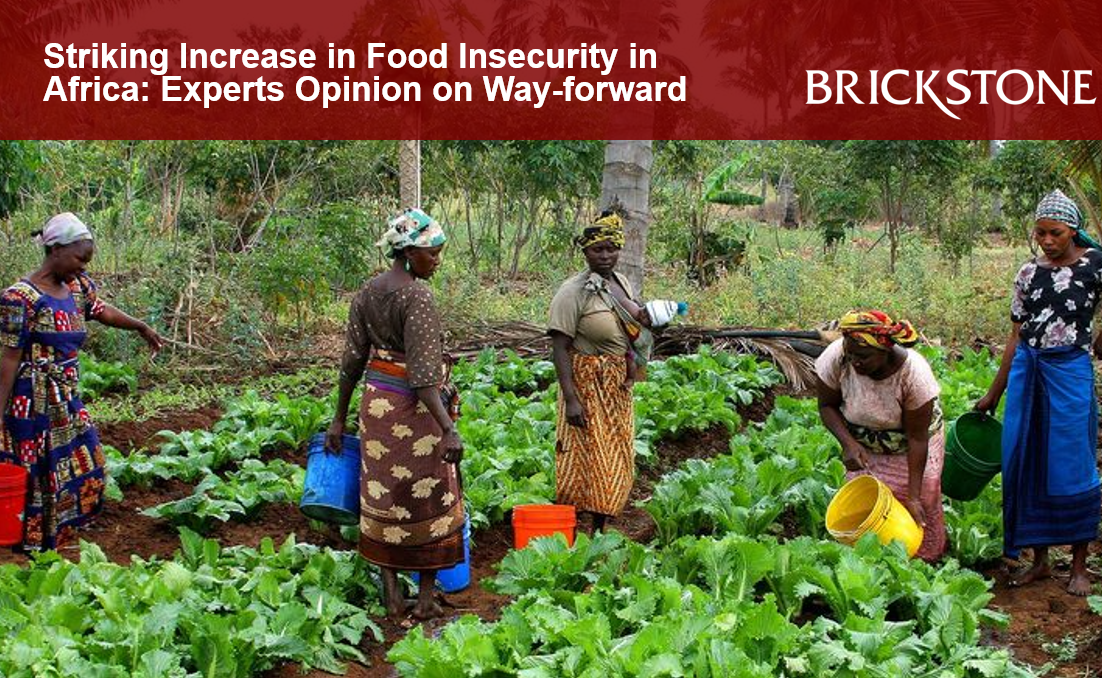Striking Increase in Food Insecurity in Africa: Experts Opinion on Way-forward
Food Insecurity in Africa
Food Insecurity in Africa is off track. The situation keeps aggravating as soaring food prices, inflation, conflict and climate change are plunging parts of the continent into a severe and enduring food crisis, magnifying hunger and mail-nutrition. This extreme situation is hitting great swathes of Africa in the Horn of Africa and the Sahel particularly hard.
According to the World Economic Forum, a fifth of people in Africa are suffering from chronic hunger, which corresponds to 20 percent of the continent’s population. Recent reports by The Food and Agriculture Organization of the United Nations (FAO) and the World Food Programme (WFP) warn that the acute food insecurity is likely to deteriorate further in 19 countries and territories during the outlook period from October 2022 to January 2023.
Against this backdrop, immediate, effective, and mutually reinforcing interventions are required to bring the continent closer to curbing hunger and food insecurity in Africa.
This article by Brickstone reviews some institutional reports and publications on the ways of curbing food insecurity in Africa.
Curbing Food Insecurity in Africa
Hunger and food security pose enormous obstacles to human and economic development in Africa. Despite currently affecting an outrageous population in the continent, experts have projected an alarming increase in the effect percentage rate in years to come, calling for the need for immediate and effective actions in Africa.
Nearly one in five people living in Africa is undernourished, the highest prevalence of all world regions. The situation is serious and threatens millions of lives and livelihoods.
The Covid-19 pandemic, energy crises, climate shocks, low productivity in agriculture, lack of infrastructure are core drivers of the rising food insecurity in the region. The economic fallout from the multiple crises affecting the region has lowered household incomes, increased poverty, widened inequality and heightened food insecurity.
The following are various experts recommendations on curbing food insecurity in Africa:
- Promoting adult literacy as a way of empowerment. According to Alltech, one major key to that empowerment is literacy. According to data from the United Nations, the adult literacy rate in sub-Saharan Africa is around 63% — meaning that one in three adults in the region, or some 182 million people, cannot read. And while some African countries have higher literacy rates, many are actually lower: South Sudan’s 35% literacy rate is among the lowest in the world. Promoting adult literacy, both via governments and NGOs, leads to more educated adults across Africa, which has positive, long-term effects related to food, nutrition and families.
- Improving water security as a core driver to relieving hunger in Africa. According to the FOA, the development of water resources and increasing efficiency in water use are central to ensuring food security and will become increasingly important as population increases. Freshwater resources in the Horn of Africa are under severe natural and social pressure. Lack of water is a serious impediment to intensifying agriculture and to opening up new land. Water delivery infrastructure, including small-scale irrigation systems and larger, more expensive dams, reservoirs and canal networks, need to be developed.
- Increasing intra-African trade as a way to raise the resilience of the domestic and regional food markets to shocks can help strengthen food insecurity in Africa. According to The Ecdpm, the AfCFTA is not just an opportunity for economic growth and development, but a necessity to ensure food security and resilience on the continent. However, many things need to happen before increased regional trade becomes a reality, including shifting policy focus towards making food crop production more attractive, creating and strengthening regional food value chains and ensuring sufficient trade infrastructure – all in a politically smart and sensitive way.
- Helping small, resource-poor farmers is another way of strengthening food security in Africa. According to the Food and Agriculture Organization, food production, distribution and access are fundamental to solving the problem of chronic food insecurity in rural areas. Increased agricultural production must, therefore, be at the core of a strategy to help small, resource-poor farmers. Their livelihoods can be improved in a sustainable way, through a combination of agricultural technologies and support services, access to markets and credit, rural enterprises and agro processing, all supported by the delivery of sound education and health services.
- Improving soil health to increase food production. According to Alltech, the production of food sources cannot be increased without addressing soil health. Unhealthy, malnourished soil leads to malnourished crops that wither instead of thriving. Finding ways to improve soil health — like rotating in legumes to boost the nitrogen in the soil and supplementing malnourished soils with nutrients — helps foster healthier crops and establishes farming practices that will be more sustainable over time.
- Promoting irrigation for small farmers as a way of increasing productivity, income, and improving livelihoods. According to the FOA, moisture is the key to agricultural production in the Horn of Africa, and failing rains have been the predominant cause of famine in the region. Food and water security are inextricably linked and can only be achieved through concerted action to raise water productivity by maximizing crop production from both rain-fed and irrigated agriculture by a more effective use of water. “More crop per drop” has become the overriding strategy, aimed at increasing outputs per unit of rain and per unit of irrigation water.
- Protecting food supply chains and consider them essential services. While locking down the population may be an adequate measure in curbing food insecurity in Africa, and we hear that many governments are imposing curfews among other measures, food supply chains should be considered as essential services as are health, pharmacy, banking, etc. According to Agrilinks, many governments are doing this and countries in Africa could learn from this action. If borders are closed, governments should allow for essential goods and businesses, including the movement of food, to continue.
- Prioritizing the needs of women and gender equality is another way to mitigate food insecurity in Africa. Gender inequality is still rampant in many countries in Africa and this pandemic could exacerbate the problem. When it comes to food and nutrition security, women play a significant role in food production as well as transformation and food preparation. With school closed, women will have an additional burden of care. Governments should sensitize men, boys and other non gender binary people to consider splitting responsibility at home. Governments should also ensure that all measures and policies are gender-sensitive and do not further widen the gender gap. Social protection services should also continue to operate and ensure sensitization against gender-based violence, which is at a risk of increasing with the social distancing and shelter-in-place measures.
Read more on curbing food insecurity here.
Why not contact us to make your Project Happen
Our advisors and consultants would be able to schedule an online meeting with you to discuss your project with the overall objective of seeking ways to achieve the “bankability” and protection of the long term asset value of your project. Request a Meeting Now






